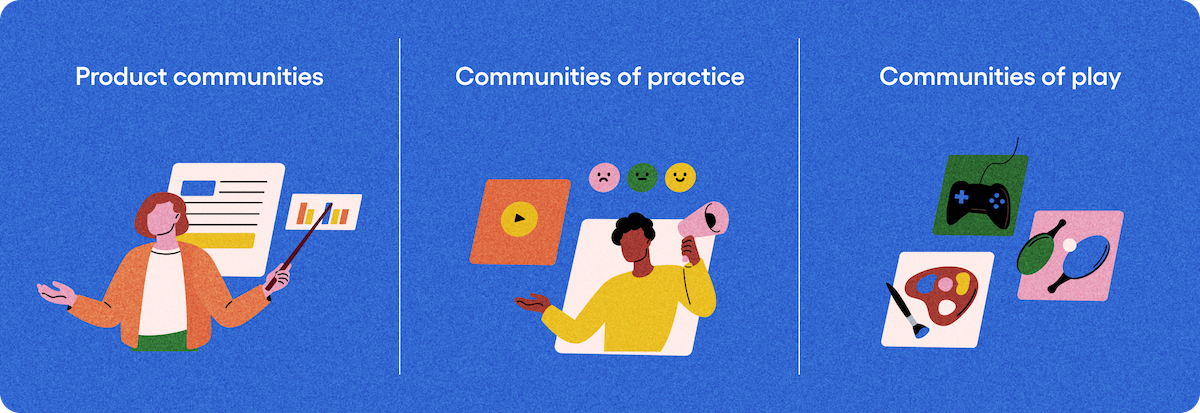Community-led growth: connecting every part of the buyer’s journey

Buyer behavior is changing and customer acquisition costs are rising.
Engagement on paid platforms is trending down, the buyers journey has morphed into sporadic interactions cross-platform, and there are there are more advertisers than ever fighting for a finite amount of consumer attention.
Some things that stand out against all that noise? Authenticity. Connection. Value.
Brands build communities to strengthen every facet of business. Even though communities are viewed as a marketing tactic, they can be integral to improving your product and customer service practices.
Many businesses aren’t taking advantage of their greatest asset—their customers. Using the power of community to propel your business forward, you’ll always be one step ahead of your buyers’ expectations.
What is community-led growth?
The premise of community-led growth is simple. It leverages the power of your user community to create a successful product and business.
- Online communities can increase your engagement by 21%.
- 66% of community members say that communities have made an impact on brand loyalty.
- 68% of branded communities report that the community has helped them generate new leads.
Most product-led companies approach community as an afterthought. However, community becomes crucial to how customers use your product. Community isn’t just a marketing tactic; it is a way for your business to continue improving and delivering value.
Take Reddit as an example. Reddit is a community-centric network by its very nature, but the company continually makes investments and improvements to strengthen its communities, including working with Sendbird to implement user-to-user chat.
Human beings have an innate need for emotional connection—a trait evident in everything we do. This need to develop relationships and belong to something more significant has driven our actions since the dawn of time.
Community-led growth is about optimizing your business process to satisfy that need for human connection. A successful community-led business incorporates social interaction at every stage of the product and customer lifecycle without making it seem forced or unnatural. It brings the customer directly into the heart of the business.

Take customer relationships to the next level.
How to build a community-led business from scratch
Turning your product’s users into your greatest advocates takes time. Finding the people to build a brand community takes time and effort, and is something you can do whether you have 5 customers or 50 million.
Your go-to-community strategy needs to include internal alignment, time, and an understanding of the nature of community. The reality is that in order to be truly product-centric, you have to be community-centric.
Step 1: Defining your community type
“Why do people want to join my community?”
How you answer this question will determine which platforms you choose to base your community on and how you source users for your community.

Product communities are the most popular business community, built around showcasing a particular product or service. Then there are communities of practice based around a common goal everyone in the community wants to achieve, such as social media marketing or video blogging. Finally, communities of play are built around video games, athletics, art subjects, and more.
A great example of a product community is Glossier. Glossier’s UGC took over the beauty scene and became their main marketing tactic as customers shared photos of their favorite products in “shelfies” and flatlays.
Headspace is a community of practice. As a meditation app, practice is at the center of their model.
Strava is built around connecting users through running, also known as a community of play. Strava makes a great community of play because, according to CEO James Quarles, sports have been inherently social since way before social networks happened. Strava fosters that community through posts and activity feeds.
Step 2: Finding your community platform
Online forums, social media, the comments section of a video, in-app activity feeds, reviews on your brand’s website, and a Slack group for VIP customers are examples of community platforms.
Many businesses like to be active on many channels instead of focusing on one. Some companies prefer LinkedIn to Twitter or TikTok to Facebook.
Other companies have apps that allow them to build a community within their own platform.
Hostelworld provides customers with hostel accommodations all around the globe. Many of their customers are solo travelers and benefit from meeting other Hostelworld travelers. Sendbird helped Hostelworld design a community experience that adds significant value to the customer’s experience.
At Sendbird, we recommended a “buy, then build” approach to app building. Thanks to the transformative power of APIs, it’s now possible to build your community without starting everything from scratch.
Step 3: Gaining your initial members
Gaining momentum is one of the biggest struggles of getting a community ready for lift-off. You must provide significant value to members who join your community early on and actively encourage them to participate in conversations about your brand.
To do that, lean in on the customers you already have and encourage them to initiate a conversation where they already are. Start a LinkedIn brand-ambassadors program and reach out to customers who love you. Get the conversation started and see what you learn.
You can also spread out to different social and community platforms to see if communities exist there or not. One way to do this for a new platform is to be active on the channel for one month to see if that focus moves the needle in any significant way.
If your customer base is already in-app, you can hold relevant webinars and create roundtable discussions that engage your customers. Providing value is a fantastic way to start building a community.
Step 4: Gathering data and implementing feedback
Business communities don’t just help with marketing and acquisition. Community members are great survey respondents and can provide valuable feedback on improving your product.
Your users will often have feedback on different aspects of your business. By using surveying and analytics tools to automate the process and collect data at scale, you can significantly improve the experience for everyone.
Sendbird Analytics lets you track essential metrics across nine separate categories and use your dashboard to get a bird’s eye view of all the important stats affecting your community. You can also export your data into various formats or use third-party integrations to collect and analyze in your preferred platform.
Step 5: Scale for online and offline
Once you’ve created a sizeable membership, you can leverage your online community to host in-person conferences and other networking events in the physical world. The goal of these events isn’t to make sales but to collect leads and discover new opportunities.
Aside from the benefits of direct human-to-human interaction, in-person events can further solidify your network and reveal new ways to improve your product and community. The data you collect from these events can be helpful from both sales and product development perspectives.
Final step: Deciding on the tools you’ll need for your community
Sendbird is an all-in-one community-building platform that lets you integrate social features into your mobile or web app. With our powerful API, you can add live chat, voice call, and video conferencing features to your existing apps to create a seamless community experience that encourages and rewards active participation.
From interactive gamification to advanced analytics, we have several tools available to help you make the most out of your community. Multilingual support allows you to scale your community across different cultures, and moderation tools enable you to maintain a positive community experience at all times.
Want to learn more about how Sendbird can help you make the most of your community-led business? Schedule a call with our sales team today.










